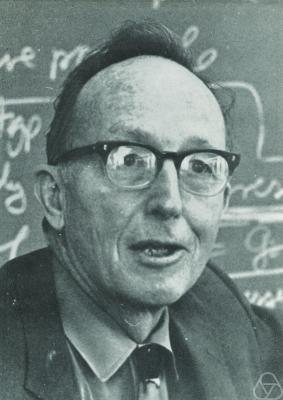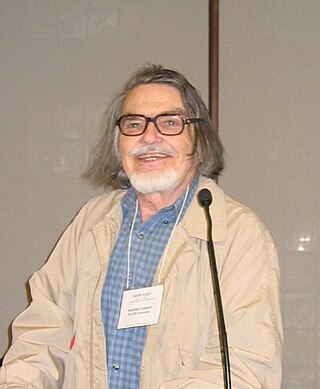Related Research Articles

Category theory is a general theory of mathematical structures and their relations that was introduced by Samuel Eilenberg and Saunders Mac Lane in the middle of the 20th century in their foundational work on algebraic topology. Category theory is used in almost all areas of mathematics. In particular, many constructions of new mathematical objects from previous ones that appear similarly in several contexts are conveniently expressed and unified in terms of categories. Examples include quotient spaces, direct products, completion, and duality.
In mathematics, a polynomial sequence is a sequence of polynomials indexed by the nonnegative integers 0, 1, 2, 3, ..., in which each index is equal to the degree of the corresponding polynomial. Polynomial sequences are a topic of interest in enumerative combinatorics and algebraic combinatorics, as well as applied mathematics.
In mathematics before the 1970s, the term umbral calculus referred to the surprising similarity between seemingly unrelated polynomial equations and certain shadowy techniques used to "prove" them. These techniques were introduced by John Blissard and are sometimes called Blissard's symbolic method. They are often attributed to Édouard Lucas, who used the technique extensively.

Saunders Mac Lane was an American mathematician who co-founded category theory with Samuel Eilenberg.

Israel Moiseevich Gelfand, also written Israïl Moyseyovich Gel'fand, or Izrail M. Gelfand was a prominent Soviet-American mathematician. He made significant contributions to many branches of mathematics, including group theory, representation theory and functional analysis. The recipient of many awards, including the Order of Lenin and the first Wolf Prize, he was a Foreign Fellow of the Royal Society and professor at Moscow State University and, after immigrating to the United States shortly before his 76th birthday, at Rutgers University. Gelfand is also a 1994 MacArthur Fellow.

Armand Borel was a Swiss mathematician, born in La Chaux-de-Fonds, and was a permanent professor at the Institute for Advanced Study in Princeton, New Jersey, United States from 1957 to 1993. He worked in algebraic topology, in the theory of Lie groups, and was one of the creators of the contemporary theory of linear algebraic groups.
In mathematics and computer science, computational number theory, also known as algorithmic number theory, is the study of computational methods for investigating and solving problems in number theory and arithmetic geometry, including algorithms for primality testing and integer factorization, finding solutions to diophantine equations, and explicit methods in arithmetic geometry. Computational number theory has applications to cryptography, including RSA, elliptic curve cryptography and post-quantum cryptography, and is used to investigate conjectures and open problems in number theory, including the Riemann hypothesis, the Birch and Swinnerton-Dyer conjecture, the ABC conjecture, the modularity conjecture, the Sato-Tate conjecture, and explicit aspects of the Langlands program.
In mathematics, operator theory is the study of linear operators on function spaces, beginning with differential operators and integral operators. The operators may be presented abstractly by their characteristics, such as bounded linear operators or closed operators, and consideration may be given to nonlinear operators. The study, which depends heavily on the topology of function spaces, is a branch of functional analysis.

David Orlin Hestenes is a theoretical physicist and science educator. He is best known as chief architect of geometric algebra as a unified language for mathematics and physics, and as founder of Modelling Instruction, a research-based program to reform K–12 Science, Technology, Engineering, and Mathematics (STEM) education.

Serge Lang was a French-American mathematician and activist who taught at Yale University for most of his career. He is known for his work in number theory and for his mathematics textbooks, including the influential Algebra. He received the Frank Nelson Cole Prize in 1960 and was a member of the Bourbaki group.

Joachim "Jim" Lambek was a Canadian mathematician. He was Peter Redpath Emeritus Professor of Pure Mathematics at McGill University, where he earned his PhD degree in 1950 with Hans Zassenhaus as advisor.

Tom Mike Apostol was an American analytic number theorist and professor at the California Institute of Technology, best known as the author of widely used mathematical textbooks.
Undergraduate Texts in Mathematics (UTM) is a series of undergraduate-level textbooks in mathematics published by Springer-Verlag. The books in this series, like the other Springer-Verlag mathematics series, are small yellow books of a standard size.
Geometry is a branch of mathematics concerned with properties of space such as the distance, shape, size, and relative position of figures. Geometry is, along with arithmetic, one of the oldest branches of mathematics. A mathematician who works in the field of geometry is called a geometer. Until the 19th century, geometry was almost exclusively devoted to Euclidean geometry, which includes the notions of point, line, plane, distance, angle, surface, and curve, as fundamental concepts.
Harold Mortimer Edwards, Jr. was an American mathematician working in number theory, algebra, and the history and philosophy of mathematics.

Sheldon Jay Axler is an American mathematician and textbook author. He is a professor of mathematics and the Dean of the College of Science and Engineering at San Francisco State University.

Jonathan Micah Rosenberg is an American mathematician, working in algebraic topology, operator algebras, K-theory and representation theory, with applications to string theory in physics.

David Archibald Cox is a retired American mathematician, working in algebraic geometry.
James Edward Humphreys was an American mathematician who worked in algebraic groups, Lie groups, and Lie algebras and applications of these mathematical structures. He is known as the author of several mathematical texts, such as Introduction to Lie Algebras and Representation Theory and Reflection Groups and Coxeter Groups.
References
- ↑ Zeilberger, Doron (1985). "Review: The umbral calculus, by Steven Roman" (PDF). Bull. Amer. Math. Soc. (N.S.). 13 (1): 73–76. doi: 10.1090/s0273-0979-1985-15374-1 .